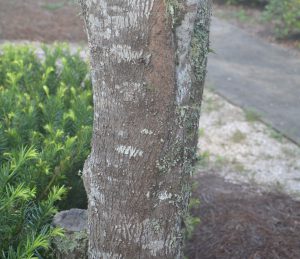
By Les Harrison
Wakulla County Extension Director
Symptoms are usually the first clue that something is wrong. It can be a fever, a cough, fatigue or a number of other indicators in people, pets or livestock.
The severity of the problem sometimes can be gauged by the symptom itself. Early recognition and the appropriate treatment are critical to a successful outcome.
This concept carries far beyond the human and animals involvement with disease. A good example of this in Wakulla County is lichens on the surface of shrubs and trees.
Lichens are composed of algae and fungi living together in a symbiotic fashion which is beneficial to both organisms, but not necessarily the host plant. They are found in a wide variety of locations around the planet, including some exceptionally harsh environments.
The fungi play an important role in the nutrient recycling and organic residue decomposition. They are responsible for the breakdown of dead organic materials so it may be converted into a useable form for utilization by other life forms.
The algae processes atmospheric carbon dioxide into organic carbon sugars to supply nutrients for both organisms. By working together, albeit unconsciously, both are able to prosper in environments where they would individually fail.
Lichens can be found in a variety of locations in Wakulla County. One of the most obvious, at least to homeowners and gardeners, is on shrubs and trees. In many cases the lichens are blamed for the decline of the plant or tree.
The reality is the lichens are opportunistic and are completing the natural cycle. If the lichens were not on the job of consuming dead organic matter, something else would be aiding the decay of the material.
While it will not cure the problem, there is a method to reduce lichens on home landscape plants and trees. The application of a copper based fungicide will remove them, at least temporarily.
Another common Wakulla County lichen combination is deer moss. The grey-green clusters have a cloud-like appearance and a resemblance to Spanish moss, but are located exclusively on the forest floor.
Deer moss is very slow growing with large mats taking many years, even multiple decades, to develop. Florida’s natural fire cycle will kill this lichen. When large mats are encountered in the woods, it is an indication the area has not burn recently.
Deer moss has a miniscule root structure and gets its moisture from the air, like all lichens. During periods of drought it will be crunchy and delicately fragile.
The recent rains have delivered ample moisture and insured the clumps are soft and pliable. This hydration process takes only a short period and is common to all lichen types.
Even before recorded history, lichens have had multiple uses, depending on the culture and time period. Some populations in northern Eurasia and North America have utilized lichens as food, on a regular basis or as a means of survival during famine.
Some of these same peoples have utilized lichens as a basis for textile dyes. In recent years synthetic dyes have replace most of these natural dyes.
One of the most common contemporary uses for deer moss is as miniature trees and shrubs for model railroaders and architects.
Staying aware of symptoms and surrounding allows the home landscape owner to better manage their unique situation. Love them or hate them, lichens are here to stay.
To learn more about lichens contact the UF/IFAS Wakulla County Extension Office at 850-926-3931 or https://blogs.ifas.ufl.edu/wakullaco/ .
 0
0
